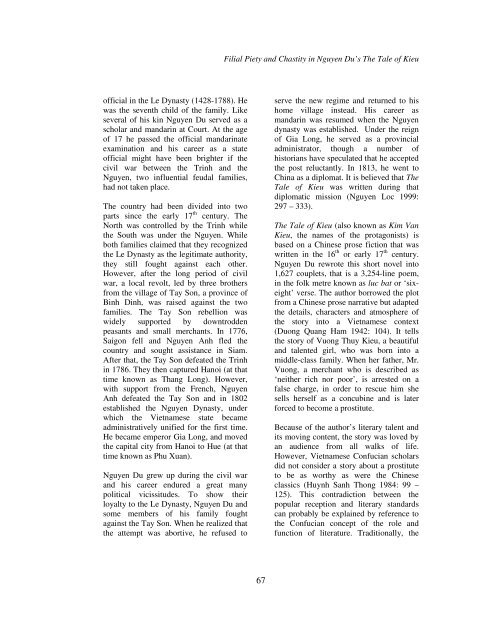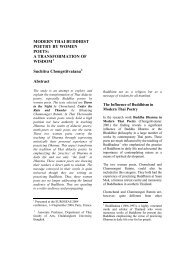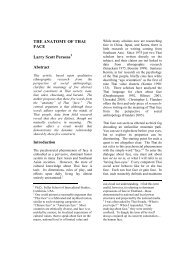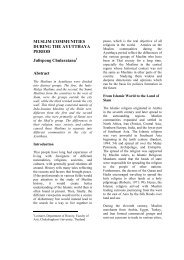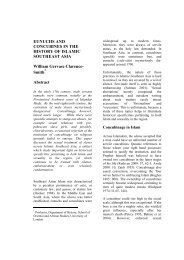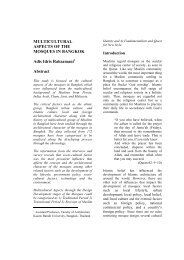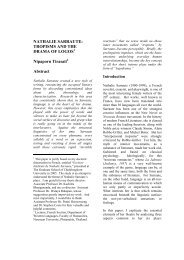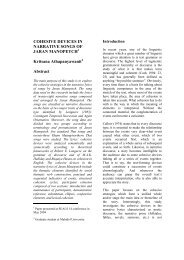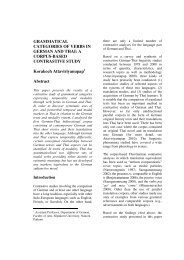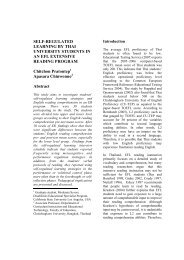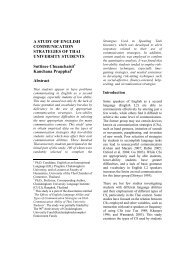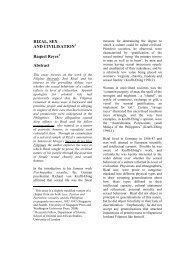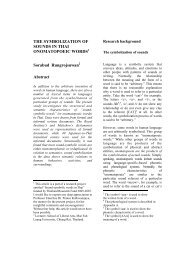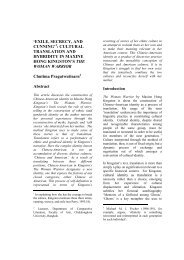Filial Piety and Chastity in Nguyen Du's The Tale of Kieu - Manusya ...
Filial Piety and Chastity in Nguyen Du's The Tale of Kieu - Manusya ...
Filial Piety and Chastity in Nguyen Du's The Tale of Kieu - Manusya ...
Create successful ePaper yourself
Turn your PDF publications into a flip-book with our unique Google optimized e-Paper software.
<strong>Filial</strong> <strong>Piety</strong> <strong>and</strong> <strong>Chastity</strong> <strong>in</strong> <strong>Nguyen</strong> Du’s <strong>The</strong> <strong>Tale</strong> <strong>of</strong> <strong>Kieu</strong><strong>of</strong>ficial <strong>in</strong> the Le Dynasty (1428-1788). Hewas the seventh child <strong>of</strong> the family. Likeseveral <strong>of</strong> his k<strong>in</strong> <strong>Nguyen</strong> Du served as ascholar <strong>and</strong> m<strong>and</strong>ar<strong>in</strong> at Court. At the age<strong>of</strong> 17 he passed the <strong>of</strong>ficial m<strong>and</strong>ar<strong>in</strong>ateexam<strong>in</strong>ation <strong>and</strong> his career as a state<strong>of</strong>ficial might have been brighter if thecivil war between the Tr<strong>in</strong>h <strong>and</strong> the<strong>Nguyen</strong>, two <strong>in</strong>fluential feudal families,had not taken place.<strong>The</strong> country had been divided <strong>in</strong>to twoparts s<strong>in</strong>ce the early 17 th century. <strong>The</strong>North was controlled by the Tr<strong>in</strong>h whilethe South was under the <strong>Nguyen</strong>. Whileboth families claimed that they recognizedthe Le Dynasty as the legitimate authority,they still fought aga<strong>in</strong>st each other.However, after the long period <strong>of</strong> civilwar, a local revolt, led by three brothersfrom the village <strong>of</strong> Tay Son, a prov<strong>in</strong>ce <strong>of</strong>B<strong>in</strong>h D<strong>in</strong>h, was raised aga<strong>in</strong>st the tw<strong>of</strong>amilies. <strong>The</strong> Tay Son rebellion waswidely supported by downtroddenpeasants <strong>and</strong> small merchants. In 1776,Saigon fell <strong>and</strong> <strong>Nguyen</strong> Anh fled thecountry <strong>and</strong> sought assistance <strong>in</strong> Siam.After that, the Tay Son defeated the Tr<strong>in</strong>h<strong>in</strong> 1786. <strong>The</strong>y then captured Hanoi (at thattime known as Thang Long). However,with support from the French, <strong>Nguyen</strong>Anh defeated the Tay Son <strong>and</strong> <strong>in</strong> 1802established the <strong>Nguyen</strong> Dynasty, underwhich the Vietnamese state becameadm<strong>in</strong>istratively unified for the first time.He became emperor Gia Long, <strong>and</strong> movedthe capital city from Hanoi to Hue (at thattime known as Phu Xuan).<strong>Nguyen</strong> Du grew up dur<strong>in</strong>g the civil war<strong>and</strong> his career endured a great manypolitical vicissitudes. To show theirloyalty to the Le Dynasty, <strong>Nguyen</strong> Du <strong>and</strong>some members <strong>of</strong> his family foughtaga<strong>in</strong>st the Tay Son. When he realized thatthe attempt was abortive, he refused toserve the new regime <strong>and</strong> returned to hishome village <strong>in</strong>stead. His career asm<strong>and</strong>ar<strong>in</strong> was resumed when the <strong>Nguyen</strong>dynasty was established. Under the reign<strong>of</strong> Gia Long, he served as a prov<strong>in</strong>cialadm<strong>in</strong>istrator, though a number <strong>of</strong>historians have speculated that he acceptedthe post reluctantly. In 1813, he went toCh<strong>in</strong>a as a diplomat. It is believed that <strong>The</strong><strong>Tale</strong> <strong>of</strong> <strong>Kieu</strong> was written dur<strong>in</strong>g thatdiplomatic mission (<strong>Nguyen</strong> Loc 1999:297 – 333).<strong>The</strong> <strong>Tale</strong> <strong>of</strong> <strong>Kieu</strong> (also known as Kim Van<strong>Kieu</strong>, the names <strong>of</strong> the protagonists) isbased on a Ch<strong>in</strong>ese prose fiction that waswritten <strong>in</strong> the 16 th or early 17 th century.<strong>Nguyen</strong> Du rewrote this short novel <strong>in</strong>to1,627 couplets, that is a 3,254-l<strong>in</strong>e poem,<strong>in</strong> the folk metre known as luc bat or ‘sixeight’verse. <strong>The</strong> author borrowed the plotfrom a Ch<strong>in</strong>ese prose narrative but adaptedthe details, characters <strong>and</strong> atmosphere <strong>of</strong>the story <strong>in</strong>to a Vietnamese context(Duong Quang Ham 1942: 104). It tellsthe story <strong>of</strong> Vuong Thuy <strong>Kieu</strong>, a beautiful<strong>and</strong> talented girl, who was born <strong>in</strong>to amiddle-class family. When her father, Mr.Vuong, a merchant who is described as‘neither rich nor poor’, is arrested on afalse charge, <strong>in</strong> order to rescue him shesells herself as a concub<strong>in</strong>e <strong>and</strong> is laterforced to become a prostitute.Because <strong>of</strong> the author’s literary talent <strong>and</strong>its mov<strong>in</strong>g content, the story was loved byan audience from all walks <strong>of</strong> life.However, Vietnamese Confucian scholarsdid not consider a story about a prostituteto be as worthy as were the Ch<strong>in</strong>eseclassics (Huynh Sanh Thong 1984: 99 –125). This contradiction between thepopular reception <strong>and</strong> literary st<strong>and</strong>ardscan probably be expla<strong>in</strong>ed by reference tothe Confucian concept <strong>of</strong> the role <strong>and</strong>function <strong>of</strong> literature. Traditionally, the67


